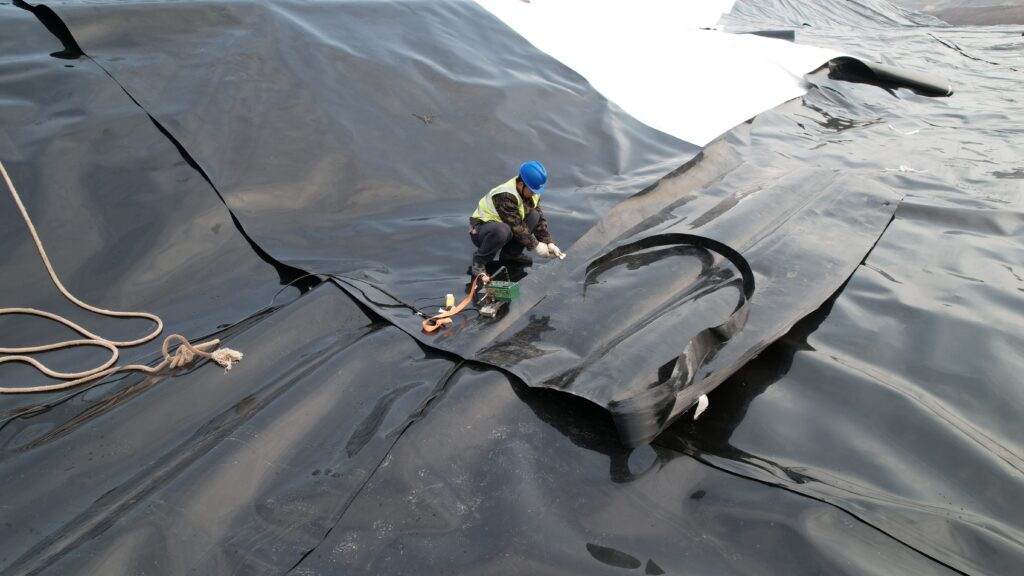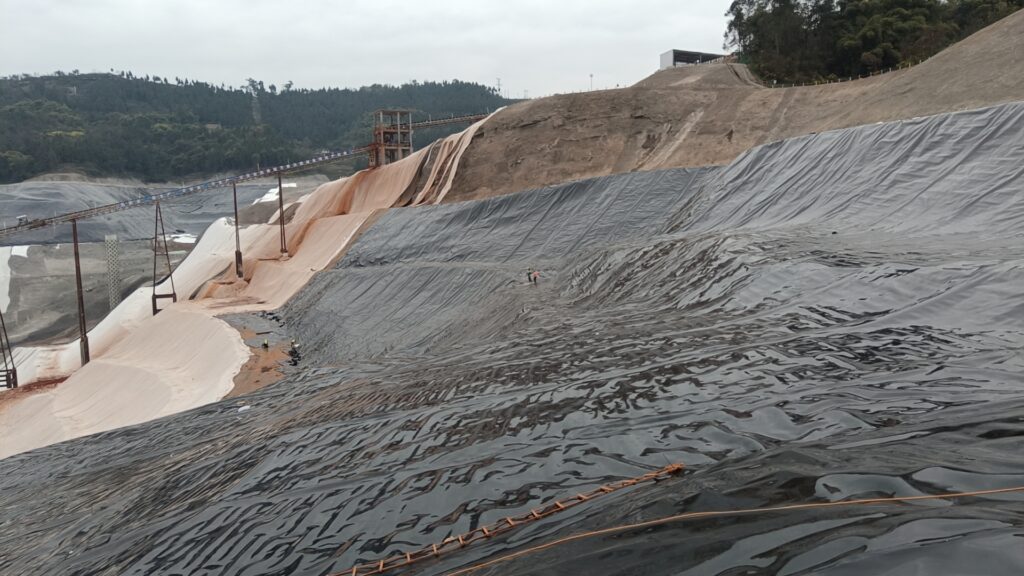How to choose hdpe geomembrane in engineering projects
Selecting the right HDPE (High-Density Polyethylene) geomembrane for engineering projects involves several considerations to ensure optimal performance and longevity. Here’s a step-by-step guide:
Understand Project Requirements: Determine the specific needs of your engineering project, including environmental conditions, site characteristics, containment requirements, and expected lifespan of the geomembrane.
Material Quality: HDPE geomembranes are available in various grades and thicknesses. Ensure that the geomembrane meets industry standards and is manufactured using high-quality materials to guarantee durability and performance.
Thickness Selection: Choose the appropriate thickness of HDPE geomembrane based on factors such as the severity of site conditions, expected service life, and the level of protection required against punctures, tears, and chemical exposure.
Strength and Flexibility: Assess the strength and flexibility of the geomembrane to withstand installation stresses, settlement, temperature fluctuations, and potential ground movement without compromising its integrity.
Chemical Resistance: Evaluate the chemical compatibility of the HDPE geomembrane with substances present in the surrounding environment, including soil, water, and any contaminants that may come into contact with the geomembrane over time.
UV Resistance: If the geomembrane will be exposed to sunlight, select a product with UV stabilization additives to prevent degradation and ensure long-term performance in outdoor applications.
Seaming and Installation Methods: Consider the seaming techniques and installation methods compatible with the chosen HDPE geomembrane to achieve proper sealing and minimize the risk of leaks or failure at seams and penetrations.
Manufacturer Reputation and Support: Choose a reputable manufacturer or supplier with a track record of delivering high-quality HDPE geomembranes and providing technical support, installation guidance, and warranty coverage as needed.
Cost Considerations: While cost is a factor, prioritize quality and performance over upfront savings to avoid potential issues and costly repairs or replacements in the future.
Compliance with Regulations: Ensure that the selected HDPE geomembrane complies with relevant regulatory requirements, industry standards, and engineering specifications applicable to your project, such as ASTM standards or local environmental regulations.
By carefully considering these factors and consulting with experienced professionals, you can confidently choose the right HDPE geomembrane for your engineering project, ensuring effective containment, environmental protection, and long-term performance.

The role of hdpe geomembrane in reservoir engineering
HDPE (High-Density Polyethylene) geomembranes play a crucial role in reservoir engineering, particularly in the construction and maintenance of reservoirs. Here are some key roles they fulfill:
Waterproofing: One of the primary functions of HDPE geomembranes in reservoir engineering is to provide waterproofing and prevent seepage. Reservoirs often contain valuable water resources, and preventing leakage is essential for water conservation and storage efficiency.
Containment: HDPE geomembranes serve as a reliable barrier to contain water within the reservoir structure. They help maintain the desired water level and prevent loss due to seepage into the surrounding soil.
Environmental Protection: Geomembranes help protect the environment by preventing contaminants from leaching into the soil and groundwater. This is especially important in reservoirs used for drinking water supply, irrigation, aquaculture, or industrial processes.
Seepage Control: By effectively blocking water seepage, HDPE geomembranes help maintain the stability of the reservoir structure and prevent erosion of embankments or surrounding terrain. This is crucial for ensuring the long-term integrity and safety of the reservoir.
Geomembrane Liners: In some cases, geomembranes are used as liners within reservoirs to provide additional protection against abrasion, punctures, and chemical damage. These liners enhance the durability and longevity of the reservoir infrastructure.
Slope Protection: Geomembranes can be used to reinforce slopes within reservoirs, providing stability and erosion control. They help prevent soil erosion and slippage, particularly on steep embankments or dam walls.
Maintenance of Water Quality: By preventing seepage and minimizing the ingress of external contaminants, HDPE geomembranes contribute to maintaining water quality within the reservoir. This is essential for ensuring that the stored water remains safe for its intended use.
Integration with Geotechnical Components: HDPE geomembranes are often integrated into the overall geotechnical design of reservoirs, working in conjunction with other materials such as geotextiles, clay liners, and concrete structures to achieve the desired performance and stability.
Flexibility and Adaptability: HDPE geomembranes offer flexibility and adaptability to accommodate variations in terrain, settlement, and environmental conditions. They can be customized to fit irregular shapes and sizes, making them suitable for a wide range of reservoir designs.
Overall, HDPE geomembranes play a critical role in reservoir engineering by providing essential waterproofing, containment, and environmental protection, ultimately contributing to the efficient storage and management of water resources.

How to weld hdpe geomembrane in engineering
Welding HDPE (High-Density Polyethylene) geomembrane is a critical aspect of engineering projects where these liners are used for containment purposes. Here’s a general guide on how to weld HDPE geomembrane:
Preparation:
Clean the geomembrane surfaces thoroughly to remove any dirt, debris, or contaminants that could affect the welding process.
Ensure that the geomembrane sheets are properly aligned and overlapped according to the welding specifications.
Selecting the Welding Method:
There are several methods for welding HDPE geomembrane, including hot wedge welding, hot air welding, and extrusion welding.
Choose the appropriate welding method based on factors such as the thickness of the geomembrane, site conditions, and the availability of welding equipment.
Setting Up the Welding Equipment:
Prepare the welding equipment according to the selected method. This may involve adjusting temperature settings, pressure settings, and other parameters as per the manufacturer’s recommendations.
Ensure that the welding equipment is in good working condition and calibrated properly for consistent and reliable welds.
Performing the Weld:
Start the welding process by bringing the heated welding element into contact with the geomembrane surfaces to be welded.
Apply consistent pressure and maintain a steady welding speed to ensure proper fusion of the geomembrane sheets.
Follow the welding pattern and technique specified in the project’s welding plan, ensuring overlap widths and bead dimensions are in accordance with design requirements.
During welding, monitor the quality of the weld bead, ensuring it is uniform, without voids or defects that could compromise the integrity of the seam.
Quality Control:
After completing the weld, perform visual inspections to check for any signs of inadequate fusion, overheating, or other welding defects.
Conduct destructive and non-destructive testing, such as peel tests or air channel tests, to verify the integrity and strength of the weld.
Document the welding process and inspection results for quality assurance and compliance with project specifications.
Safety Precautions:
Always follow safety protocols and wear appropriate personal protective equipment (PPE) when performing HDPE geomembrane welding, including heat-resistant gloves, eye protection, and clothing.
Ensure proper ventilation in enclosed spaces to prevent the buildup of fumes or gases generated during welding.
Training and Certification:
Welding HDPE geomembrane requires specialized skills and training. Ensure that personnel involved in the welding process are adequately trained and certified in geomembrane welding techniques.
By following these steps and adhering to best practices for HDPE geomembrane welding, you can achieve strong, durable seams that provide effective containment and environmental protection in engineering projects.
近期文章
Author
-

Founded in 2002, Tinhy's team focuses on the manufacturing, marketing, installation, application and research and development of geosynthetic materials.
View all posts
